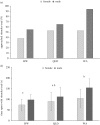The loneliness of the long-distance toad: invasion history and social attraction in cane toads (Rhinella marina)
- PMID: 29118242
- PMCID: PMC5719377
- DOI: 10.1098/rsbl.2017.0445
The loneliness of the long-distance toad: invasion history and social attraction in cane toads (Rhinella marina)
Abstract
Individuals at the leading edge of a biological invasion constantly encounter novel environments. These pioneers may benefit from increased social attraction, because low population densities reduce competition and risks of pathogen transfer, and increase benefits of information transfer. In standardized trials, cane toads (Rhinella marina) from invasion-front populations approached conspecifics more often, and spent more time close to them, than did conspecifics from high-density, long-colonized populations.
Keywords: Bufo marinus; aggregation; evolution; sociality.
© 2017 The Author(s).
Conflict of interest statement
We have no competing interests.
Figures


References
-
- Gruber J, Brown G, Whiting MJ, Shine R. 2017. Geographic divergence in dispersal-related behaviour in cane toads from range-front versus range-core populations in Australia. Behav. Ecol. Sociobiol. 71, 1–7. (10.1007/s00265-017-2266-8) - DOI
-
- Liebl AL, Martin LB. 2014. Living on the edge: range edge birds consume novel foods sooner than established ones. Behav. Ecol. 25, 1089–1096. (10.1093/beheco/aru089) - DOI
-
- Carvalho CF, Leitao AV, Funghi C, Batalha HR, Reis S, Mota PG, Lopes RJ, Cardoso GC. 2013. Personality traits are related to ecology across a biological invasion. Behav. Ecol. 24, 1081–1091. (10.1093/beheco/art034) - DOI
MeSH terms
LinkOut - more resources
Full Text Sources
Other Literature Sources

